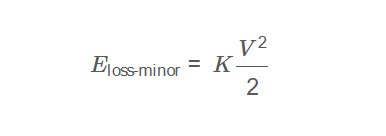1. What is a Minor Loss Coefficient Calculator?
Definition: This calculator computes the mechanical energy loss (\( E_{\text{loss-minor}} \)) due to fittings, valves, or geometry changes in pipes or ducts, using a loss coefficient (\( K \)).
Purpose: It is used in HVAC systems to quantify minor losses, which contribute to the total pressure drop in piping systems with multiple bends and fittings.
2. How Does the Calculator Work?
The calculator uses the following formula:
Minor Energy Loss:
\[
E_{\text{loss-minor}} = K \frac{V^2}{2}
\]
Where:
- \( E_{\text{loss-minor}} \): Minor energy loss (ft-lb/lb, equivalent to ft in head loss units; convertible to m)
- \( K \): Loss coefficient (dimensionless, experimentally determined)
- \( V \): Velocity (ft/s, m/s)
Unit Conversions:
- Velocity (\( V \)): ft/s, m/s (1 m/s = 3.28084 ft/s)
- Energy Loss (\( E_{\text{loss-minor}} \)): ft, m (1 ft = 0.3048 m)
Steps:
- Enter the loss coefficient (\( K \)) and velocity (\( V \)), and select the velocity unit.
- Convert \( V \) to ft/s.
- Calculate the minor energy loss using \( E_{\text{loss-minor}} = K \frac{V^2}{2} \).
- Convert the result to the selected unit (ft, m).
- Display the result, using scientific notation for values less than 0.001, otherwise with 4 decimal places.
3. Importance of Minor Loss Coefficient Calculation
Calculating minor losses is crucial for:
- HVAC Design: Accounts for energy losses in fittings, valves, and bends, ensuring accurate total pressure drop calculations.
- Energy Efficiency: Helps optimize system design by minimizing unnecessary pressure losses.
- System Performance: Ensures proper airflow and pressure distribution in HVAC piping systems.
4. Using the Calculator
Examples:
- Example 1: For \( K = 0.5 \), \( V = 10 \, \text{ft/s} \), energy loss in ft:
- Energy Loss: \( E_{\text{loss-minor}} = 0.5 \times \frac{10^2}{2} = 0.5 \times 50 = 25.0000 \, \text{ft} \)
- Example 2: For \( K = 1.2 \), \( V = 5 \, \text{m/s} \), energy loss in m:
- Convert: \( V = 5 \times 3.28084 = 16.4042 \, \text{ft/s} \)
- Energy Loss: \( E_{\text{loss-minor}} = 1.2 \times \frac{(16.4042)^2}{2} = 1.2 \times 134.549 = 161.4588 \, \text{ft} \)
- Convert to m: \( E_{\text{loss-minor}} = 161.4588 \times 0.3048 = 49.2127 \, \text{m} \)
5. Frequently Asked Questions (FAQ)
Q: What is a minor loss in HVAC systems?
A: A minor loss is the mechanical energy loss due to fittings, valves, or geometry changes in pipes or ducts, calculated as \( E_{\text{loss-minor}} = K \frac{V^2}{2} \).
Q: Why are minor losses important in HVAC systems?
A: They contribute to the total pressure drop in piping systems, especially in HVAC systems with multiple bends and fittings, affecting system efficiency and performance.
Q: Where can I find the loss coefficient (\( K \))?
A: Loss coefficients (\( K \)) are experimentally determined and can be sourced from engineering references, such as later chapters in HVAC design manuals (e.g., Chapter 9).
Minor Loss Coefficient Calculator© - All Rights Reserved 2025
 Home
Home
 Back
Back
